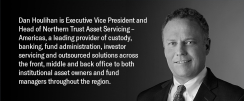Investment in human capital is essential to economic growth. Economists dating back to Adam Smith concur with this belief, so it’s hardly a novel concept. Yet in the world of investment professionals, attracting and retaining top talent has never been a more complex undertaking than it is today. Having the right people in the right positions matters a great deal in a relationship-based business with an emotionally charged subject – money – at its core.
In his role as Head of Northern Trust’s Asset Servicing Business in the Americas, Dan Houlihan has a clear view of the human capital challenges faced by the group’s investment manager clients, as well as by his own very large employer. Writ large across that landscape, Houlihan notes that, “firms are trying to ensure that they can provide a highly personalized level of service with context. That context gets built over time as you get to know what a client’s needs, expectations, and future plans are, whether it’s an institutional manager or an individual investor. All of this aims to produce a world-class experience and outcome focused on the unique needs of each client.”

A seat at the table for the next generation of leaders
Transparency demands by investors and regulators have ratcheted up the pressure on asset servicing firms to be innovative, particularly in their adoption and use of technology. It is commonly accepted that younger generations, having come of age in a digital world, are particularly adept at using technology to solve problems.
“Strong digital leadership has become absolutely critical,” says Houlihan. “That necessitates an awareness of the perils of ageism and titleism.” In other words, 30 years on the job and an impressive title don’t necessarily equate to being the smartest person in the room (nor do they rule it out).
“It’s imperative that the next generation of leaders not only have a seat at the table, but are empowered to help inform strategy by identifying what is possible, particularly as it relates to technology. The winners will be the firms that are able to leverage digital and fintech along with everything else to truly drive business performance. The technology is critical, but it’s talent that creates the technology and knows how best to leverage it,” Houlihan says.
Many long-established organizations, often set in their ways, struggle to transition from a tenure-based system for selecting and promoting employees to one based on leadership and execution. Ageism and titleism are two-way streets, however. Winning firms in the race for the better workforce will successfully knock down literal and figurative silos, and merge all of the talent at their disposal to optimize strategy and execution.
Multi-generational culture of collaboration
Millennials are no longer a marketing buzzword: they’ll soon replace baby boomers as the largest and most influential demographic, and they’re an established and critical part of both the investment industry and its clients. For many firms, the majority of today’s new hires are Millennials, who bring with them both sought-after tech savviness and expectations of their own. Accustomed to using the latest technology and the convenience that technology enables, Millennials expect the same in their workplace and will often opt for one job offer over another based in part on that preference.
“The new and next generations expect quality technology, mobility, and a work environment they find conducive both in the physical space and in operating practices,” says Houlihan. “If you believe collaboration is critical – and it is – then you have to give people the tools and space to collaborate in an agile way. Those two have to go hand in hand. Having a modern work environment is really important to drive development, faster implementation, continuous deployment. I see this with our clients, too. Some of them have lab-like settings where the dress code is different, more casual. The workspace is much more open – they’re tearing down physical barriers to enable that collaboration. It’s important for job candidates to see that. The next generation of talent isn’t going to be impressed by a dark boardroom.”
Countless studies have shown that diverse teams are better at problem solving, and that the more diverse an organization the higher its performance. A multi-generational workforce only adds to a firm’s diversity
“People who have been with a company a long time contribute substantial institutional and functional knowledge,” Houlihan says. “When that is combined with Millennial talent embracing new technologies and new ways of collaboration, the cross-pollination is hugely effective. We learn from each other and we end up in a better place. It forces us to value knowledge, experience, and skill outside of age or tenure.”
What results is less role distinction, especially in areas where the core business and technology must be more closely integrated given the pace at which technology is being competitively leveraged by brokerage firms, asset servicers, and institutional fund managers.
Keeping up with the pace of change might not come naturally to the more experienced members of a multi-generational team. Rather than fight it, says Houlihan, the objective should be to embrace diversity in all of its forms.
“I find it helpful to engage in ‘reverse mentoring’ with the next generation to make sure that I can learn from them about what apps they’re using and how they’re using them,” he says. “Getting others who have been around for a long time to realize that the world is changing and that we all have to change with it – to me, that’s harder than recruiting really good Millennial talent. I spend a lot of my time with the next generation of leaders that we’ve clearly identified as such. I want to ensure that they have a strategic context for what we’re trying to accomplish because that will make them a better change agent and, ultimately, a better leader.”





